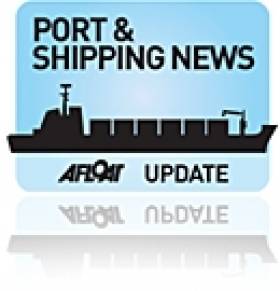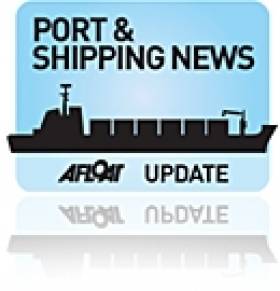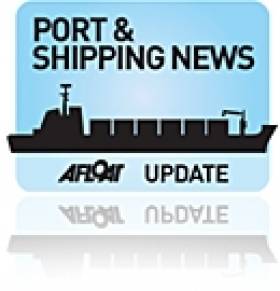Displaying items by tag: Arklow Shipping
Arklow Shipping Adds Newbuild 'Muse' to Her Sisters
#ArklowNewbuild – Arklow Shipping Ltd's latest newbuild Arklow Muse joins 'M' class sisters as part of a mixed dry-cargo fleet of 45 vessels ranging between 3,000 – 14,990dwt, writes Jehan Ashmore.
Unlike the rest of the five 'M' class series built by Mokpo Shipyard Corporation in South Korea, the 14,018dwt Arklow Muse was completed by Daesun Shipbuilding & Engineering.
The principle dimensions of the dry-cargo vessel are 136m long, a 21m beam and draught of around 8.5m.
Her classification society is Bureau Veritas. Class notation is for +100A1 +LMC,UMS, IWS (strengthened for heavy cargo) and her four holds. For example she can load a cargo of grain totaling 18,110m3 / 639,490 sq ft.
As for her power-plant, this is a main engine of the MaK 6M 43C design with a 5400kW capacity and a Jake reduction gear Rolls Royce controllable pitch propellers delivering about 14 knots.
Arklow Muse is registered at Arklow, her Irish homeport where the company headquarters are based managing the majority of the fleet. The balance of ships are operated from the chartering division Arklow Shipping N.V., located in Rotterdam.
Coincidentally, a sister of Arklow Muse, the 2010 built Arklow Mill is underway bound for Rotterdam, having yesterday loaded at the Aughinish Alumina processing plant on the Shannon Estuary.
Earlier this year, Arklow Mill had her deadweight tonnage (dwt) increased to 14,990 tonnes making her one of the largest vessels in the fleet in terms of dwt.
The work was carried out by Dublin Dry Docks in Alexandra Basin. It is also understood that the dry-docking involved a MEWIS duct fitted to the propeller to improve greater efficiency.
In addition to Arklow Mill, the Irish flagged vessel shared the Aughinish jetty with another bulker, Aom Julia of 76,000dwt. She was unloading bauxite on the adjacent berth of the Shannon estuary facility.
18 Injured as Toxic Gas Leaks from Irish Cargoship
#SHIP TOXIC LEAK - Eighteen people are being treated after toxic gas used to kill rodents escaped from an Irish flagged dry-cargoship docked at Warrenpoint, Co Down.
The cargo on board Arklow Meadow had become wet and unstable. The gas is aluminium phosphide, a pesticide used to kill small mammals such as moles and rodents.
Gardaí have been informed of the potential of the chemical compound to drift into Co Louth. It is understood they are going house-to-house in the Omeath area advising householders to stay indoors and close all windows. For more on this story, RTE.ie reports.
Afloat.ie adds that the 2010 South Korean built vessel is owned by Arklow Shipping Ltd and is one of a five 'M' class series.These vessels each have a total grain capacity of 18,110m3 as previously reported, including the Arklow Manor which last month was dry-docked in Dublin Port.
Arklow Shipping Expands Fleet into Handysize Bulker Market
#PORTS & SHIPPING – Arklow Shipping is further expanding its bulker fleet and moving into the market for larger vessels with an order for three ships in South Korea, according to Tradewinds.
The company which is headquartered in the Co. Wicklow port has booked two 35,000-dwt handysize-bulkers and a general cargoship at Daesun Shipbuilding. TradeWinds sources say Arklow is paying a premium for the ships against more competitive pricing from China.
Brokers price the Daesun bulkers at around $25.5m, which compares to similar deals in China at around $22m. As for the general cargoship, she will be delivered in the first half of 2013 and the bulkers in the second half of the year. Arklow previously signed up for a series of 14,000-dwt multipurpose (MPP) vessels at Mokpo, which later went into administration.
The orders were then passed on to Sekwang Shipbuilding only for it also to fall into financial difficulties. Daesun has had its problems too and was delisted from the Seoul Stock Exchange in April as it did not meet the bourse's financial requirements.
The latest order appears to have taken Arklow's owned fleet into the larger-handysize segment. So far it has focussed mainly on bulkers, general-cargo and MPP ships up to 14,000 dwt. It has a fleet of 55 ships including 12 newbuildings, most of which are registered in the Republic of Ireland. Arklow declines to comment on the Daesun order.
The Future’s Green, Bright and Orange
This month ASN are due delivery of the 4,700 gross tonnes Arklow Bridge, the second 'B' class newbuild was also built by the Dutch company of Bodewes Shipyards B.V. She is the fifth vessel to carry this name since Arklow Shipping was founded in 1966.
The Arklow Bridge is registered in St. John's the capital of the Caribbean island of Antigua where she will be flagged. Antigua became an associated state of the Commonwealth until it was disassociated from Britain 30 years ago.
Her sister Arklow Brook entered service this year and is designed with two holds with a total (grain and bale) capacity of 9473.1m3 or an equivalent of 33,4524 ft3.
For cargo-separation the holds can be sub-divided by a portable bulkhead in up to 8 positions. In addition to carrying agricultural-based cargoes, the 116m (OA) overall long vessel can handle 177 (TEU) containers in the hold and another 88 can be stowed on top of the hold's hatch covers. Both the holds are fitted with dehumidifier's.
The power-plant is derived from a MaK 6M32C 2999kW main engine with a Renk gearbox and Berg controllable pitch propeller that provides around 12 knots.
With the entry of Arklow Bridge, the combined fleet is over 40 ships that trade in the north-west of Europe and the Mediterranean. For further vessel statistics of the sisters click here and for a photo of the new vessel click this link.
Asides the Rotterdam based operation of ASN, the Irish side of the company is the largest indigenous owned shipping company in terms of Irish-flagged and registered tonnage. Arklow is not only the headquarter's of ASL but the homeport is also where the vessels are registered.
- Dublin Port
- Co. Wicklow
- Arklow Shipping
- Newbuilds
- The Netherlands
- Arklow Shipping Ltd
- Ports and Shipping News
- Caribbean
- DryDock
- Antigua
- British
- Dublin Port news
- Arklow Bridge
- Arklow Brook
- ASN
- Arklow Shipping B.V.
- Irishflagged
- Irishregistered
- Arklow Future
- Bodewes Shipyards
- Dutchflagged
- Antiguaflagged
- Mak
- The Commonwealth
- River Avoca
South Korean Newbuilds for Arklow Shipping
The latest newbuild for the Arklow Shipping Ltd (ASL) fleet, Arklow Meadow is due to depart from the Mokpo Shipyard Corporation, South Korea in three weeks, writes Jehan Ashmore. The 136m dry-cargo vessel will seek a cargo for the delivery voyage from the Far-Eastern shipyard to Europe.
Arklow Meadow represents the fourth in a series of six newbuilds ordered, with lead-ship Arklow Manor entering service in 2009. The following newbuilds, Arklow Marsh and Arklow Mill where delivered from the shipyard to her owners during 2010.
All the 'M'-class newbuilds are 14,000 tonnes and have four-holds with a total grain capacity of over 18,000 cubic square-metres.The vessels are powered by a MaK 6M 43C main engine which has a 5,400KW capacity through a Jake reduction gear-box and fitted to a Rolls Royce controllable pitch propeller.
ASL operate a modern fleet of dry-cargo short-sea traders and bulkers throughout Europe, Scandinavia and to the Mediterranean Sea using tonnage varying in size from 3,000-14,000 tonnes. Most to the vessels are of a singledeck, box hold design and some are fitted for container stowage. The majority of cargoes are grain, general dry-bulk and bulk commodities including those classified under IMO regulations.
ASL was established in 1966 by several family ship-owning companies and has progressed to become one of Ireland's leading indigenous ship-operators. The company has its headquarters alongside the banks of the River Avoca, Arklow in addition a management team also based in the Netherlands. Most of the 39 strong fleet are registered in the Co. Wicklow port, flying the Irish tricolour while the rest of the fleet are under the Dutch flag and registered at Rotterdam and Zaandam.


































































